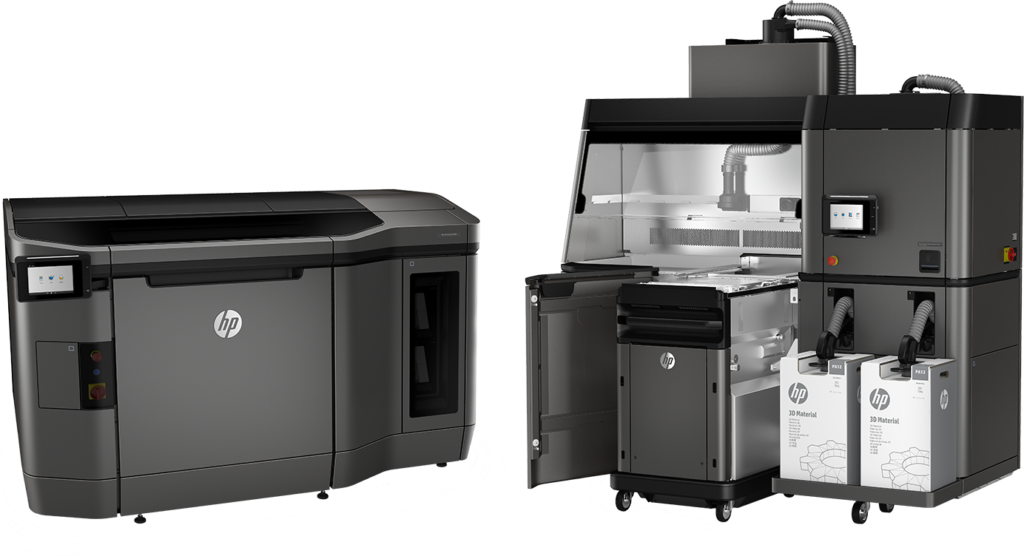 When HP unveiled their brand new Multi Jet Fusion 3D printer earlier this year, there was a lot to be excited about. Besides the machine itself, which looks to speed large-scale production by up to ten times while reducing the cost by half, HP’s open materials platform invited several major corporations to collaborate on the development of new materials for the Multi Jet Fusion system. One of the first companies to sign on was chemical giant BASF, which has now strengthened their partnership with HP to accelerate the development of materials for large-scale production.
When HP unveiled their brand new Multi Jet Fusion 3D printer earlier this year, there was a lot to be excited about. Besides the machine itself, which looks to speed large-scale production by up to ten times while reducing the cost by half, HP’s open materials platform invited several major corporations to collaborate on the development of new materials for the Multi Jet Fusion system. One of the first companies to sign on was chemical giant BASF, which has now strengthened their partnership with HP to accelerate the development of materials for large-scale production.
HP’s open materials platform not only allows partner companies to work with HP to develop materials for the Multi Jet Fusion system, it also allows customers to work directly with those partner companies to create materials for specific applications. BASF is a perfect fit for such a plan, as they already have a massive portfolio of materials including engineering thermoplastics, polyurethanes, photopolymers, photo-initiators, functional additives, stabilizers, pigments and metals. That’s a lot of raw material variety to work with when developing new formulas for 3D printing materials.
“BASF brings tremendous expertise in materials for mass production to the 3D printing industry,” said Tim Weber, Global Head, 3D Materials & Advanced Applications, HP. “By partnering with companies that have a long history in developing new materials with customers in the manufacturing industry, we want to bring 3D printing from small batch series to industrial large-scale production.”
 The strengthened partnership with HP is a springboard for BASF to broaden their overall scope of 3D printing applications. The company, whose reach goes far beyond just manufacturing into pharmaceutical applications, agricultural chemicals, energy solutions and more, jumped into bioprinting last year when they signed an agreement with biotech company Poietis to develop 4D printed skin. It won’t be hard for them to turn their existing plastic materials into 3D printing formulations, either. They already produce several popular industrial-grade engineering plastics, including:
The strengthened partnership with HP is a springboard for BASF to broaden their overall scope of 3D printing applications. The company, whose reach goes far beyond just manufacturing into pharmaceutical applications, agricultural chemicals, energy solutions and more, jumped into bioprinting last year when they signed an agreement with biotech company Poietis to develop 4D printed skin. It won’t be hard for them to turn their existing plastic materials into 3D printing formulations, either. They already produce several popular industrial-grade engineering plastics, including:
- Ultramid, a polyamide-based material
- Ultradur, based on polybutylene terephthalate
- Ultrason, based on polysulfones
- Ultraform, based on polyoxymethylene
- Ultrasint PA6 X028, a new polyamide-6 powder for sintering that possesses better mechanical stability and higher heat resistance than other polyamides used in 3D printing
Then there are the polyurethane materials, which include thermoplastic elastomers like TPU and microcellular elastomers. BASF’s wide range of polyurethanes are already used for the production of products such as household goods, shoes and sports equipment, as well as for insulation and lightweight automotive design – all markets that have seen the benefits of 3D printing, meaning that BASF already has a foot in the door of numerous industries, so to speak.
“In collaboration with HP, we combine our understanding of customer needs and applications along with expertise in materials,” said Dietmar Geiser, responsible for BASF’s 3D printing strategy at the recently launched BASF New Business division. “The HP Open Platform is driving the advancement of materials for large-scale industrial use of 3D printing in production, and BASF will play an integral role in materials development. We are working to develop durable materials that can be used for goods such as automobiles, electronics, sports articles or materials for the machining industry.”
In addition to plastics, BASF also manufactures ceramic and metal materials that should be easily convertible for 3D printing applications. To accelerate the development of their 3D printing business, the company has opened a 3D Printing Application Center in Heidelberg, Germany. Discuss in the BASF forum at 3DPB.com.
Subscribe to Our Email Newsletter
Stay up-to-date on all the latest news from the 3D printing industry and receive information and offers from third party vendors.
You May Also Like
AM Under Trump, First Thoughts: Reshoring
Constrained resources and the need to fight climate change have led to a new era of manufacturing focused on re- and nearshoring paired with supply chain resilience. In the battle...
Dyndrite Forms Strategic Partnership with Nikon SLM Solutions for Metal 3D Printing
Dyndrite, the Seattle-based software provider specializing in solutions for digital manufacturing technologies, has announced a strategic partnership with Nikon SLM Solutions to integrate Dyndrite’s LPBF Pro software with Nikon’s metal...
Nikon SLM Hits 1000th 3D Printer Milestone with Bosch Purchase
Nikon SLM Solutions has reached a significant milestone with the production of its 1000th NXG XII 600 system, among the most productive metal additive manufacturing (AM) systems in the industry....
Themes from AM Investment Strategies: Collaboration, Cost Challenges, and Expanding Markets
The 2024 Additive Manufacturing (AM) Investment Strategies event went off without a hitch. The online roundtable, hosted by AM Research (AMR) and Cantor Fitzgerald, dug into the latest trends and...






































